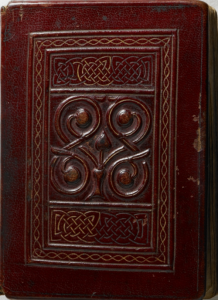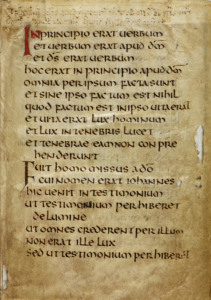Mildred Budny
(Research Group on Manuscript Evidence)
“The Tip of the Iceberg: Reconstructing Lost Manuscripts from Fragments”
Abstract of Paper
Presented at the 30th International Congress on Medieval Studies (Kalamazoo, 1995)
Session 381 on
“Rediscovering and Reconstructing Lost Manuscripts”
Sponsored by the Research Group on Manuscript Evidence
Organized by Mildred Budny
1995 Congress
[Published on our website on 7 October 2016 with updates in the forms of illustrations and links]
Note: This Abstract was published in double-column layout in the Old English Newsletter, 28:3 (Spring 1995), A-21—A-22, now archived online via Old English Newsletter, 28:3. Our publication of the text here indicates the transition from one column to the next in that Newsletter by a forward slash (/), corrects a typesetting mistake found there, and adds some links.
Abstract
Manuscripts, by definition, are hand-written copies of texts. But what constitutes a manuscript fragment, and how to we go about reconstructing lost manuscripts from one or more of them? Surveying the tip of this huge iceberg, the paper concentrates on the surviving manuscripts and fragments written or owned in England up to the year 1100, for which Helmut Gneuss’s preliminary list [= “A preliminary list of manuscripts written or owned in England up to 1100”, in Anglo-Saxon England, 9 (1981), 1—60; see Update below] numbers some 950 items preserved in collections around the world. The list grows and shrinks as attributions are revised and new material emerges; evidence for the existence and history of the group also comes from material outside that place and time-range.
The conditions of preservation and dispersal mean that each and every surviving manuscript, in whatever state, is but a fragment, or fraction, of what once existed, even if the manuscript itself seems to survive complete, with all its original leaves, including any endleaves or pastedowns, plus its original bindings and clasping mechanisms intact. Moreover, the destruction of libraries, bindings, architectural settings, décors [‘de\ABcors’ in the OEN version is a typesetting mistake], and patterns of life and thought / have robbed all manuscripts from the past of their full original contexts.
Damage, despoliation, destruction, and even conservation and rebinding have drastically reduced our count of survivors. To attempt to reconstruct the count of what once existed, we must turn to the manuscripts themselves, to piece together their fragmentary evidence, along with literary, historical, and documentary texts, ranging from chronicles and saints’ lives to book-lists and library catalogues, which mention specific books or numbers of books. Many later library catalogues of medieval collections, in England and elsewhere, contain items from our group, and probably other members as well, but not recognized or recognizable as such.
The fragmentation of the survivors is due to a wide range of causes, both accidental and deliberate. Various techniques help us to see beyond their current state, to reconstruct their original forms. Among the examples considered are Old and New Testament fragments now in Tokyo, London, and elsewhere; Gospel Book fragments in London and at Corpus Christi College, Cambridge; and Old English homily fragments now in Kansas and at Corpus.
The challenges of manuscript fragments encompass a myriad range: their discovery, rediscovery, and recovery; their present contents, both original and acquired; their states and locations, both present and past; their contents (present, intermediary, and original); their handling and conservation; the identification of their texts; the assessment of their dates, origins, and provenance; and the reconstruction of their original manuscripts, usually carried out only descriptively, rather than physically (although there are notable, sympathetic attempts by various conservators to reconstruct medieval binding structures). The techniques and methodologies for dealing with manuscript fragments are in the process of intensive evolution and refinement, so that many can help the quest of investigating, understanding, preserving, and transmitting the legacy of the past.
Armed with our knowledge of the hidden and mysterious depths of the iceberg, we can look squarely at its tip and see the survivors for what they are. Too often scholars cite Gneuss’s list of surviving manuscripts and fragments made or owned in England to 1100 as if it constitutes the evidence for the popularity or otherwise of certain texts in Anglo-Saxon England, without regard for the undoubted vast / losses of books from the period. If we find ourselves in passage on a Post-Modern Titanic, we would well to chart our course safely by recognizing the tip of the iceberg for exactly what it is.
*****
Update:
Helmut Gneuss’s groundbreaking “Preliminary List of manuscripts written or owned in England up to 1100” (1981) was updated in stages here:
- Helmut Gneuss, Handlist of Anglo-Saxon Manuscripts: A List of Manuscripts and Manuscript Fragments Written or Owned in England up to 1100 (Cambridge, 2001)
- Helmut Gneuss and Michael Lapidge, Anglo-Saxon Manuscripts: A Bibliographical Handlist of Manuscripts and Manuscript Fragments Written or Owned in England up to 1100 (Toronto, 2014)
The Cuthbert Gospel of Saint John, illustrated here, with its original binding and text intact, now belongs to the British Library as Additional MS 89000. Its characteristics were considered in the Research Group’s Seminar on the material end other evidence for “Anglo-Saxon Writing Materials and Practices”, held at the Parker Library in January 1992.
Another Seminar, held at the Parker Library in August 1994, considered “Medieval Manuscript Fragments: Their Problems and Challenges”.
The full Series of these seminars is reported here.
Medieval manuscript fragments of various kinds formed one of the central subjects for the Research Group Symposium in 2016 on “Words & Deeds”, as described in the Symposium Report and the Program Booklet.
Other Abstracts by Mildred Budny for Research Group Events or Congress Sessions are indexed respectively here and here.
*****


